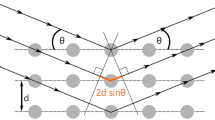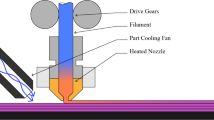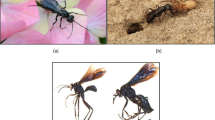Abstract
The behavior of Auxetic structures is highly dependent on the geometric parameters of the unit cell. To achieve the desired behavior, it is necessary to perform a parametric study on the unit cell. A conventional parametric study (which includes modeling and analysis with different parameters) is very time consuming and error prone. The Auxetica plugin was produced to solve this problem. Auxetica is an Abaqus plugin developed to estimate Auxetic structures' performance. In this paper, the features and instructions of this plugin are presented. This tool can automatically generate and analyze re-entrant, chiral, (Tri-chiral, Tetra-chiral, Hexa-chiral) and anti-chiral (Tri-anti-chiral and Tetra-anti-chiral) in planar and cylindrical geometries. The plugin tasks can be categorized as follows: the first task is to generate a model based on parametric input. The second task is an automatic analysis and extraction of the target output. The third task is to generate models that are ready for 3D printing and testing. To validate the plugin, an experimental setup is prepared and samples which are made by 3D printing are tested. The simulation result is validated with experimental data before any parametric study would be carried out. Moreover, to understand the plugin functionality better, a parametric study has been done. This plugin helps to perform the parametric study by the user in the shortest time and with the most accuracy with the desired inputs.




















Similar content being viewed by others
References
Zadpoor AA (2016) Mechanical meta-materials. Mater. Horizons 3(5):371–381
Barchiesi E, Spagnuolo M, Placidi L (2019) Mechanical metamaterials: a state of the art. Math Mech Sol 24(1):212–234
Ebrahimi-Nejad S, Kheybari M (2018) Honeycomb locally resonant absorbing acoustic metamaterials with stop band behavior. Mater Res Express 5(10):105801
Prawoto Y (2012) Seeing auxetic materials from the mechanics point of view: a structural review on the negative Poisson’s ratio. Comput Mater Sci 58:140–153
Evans KE, Alderson A (2000) Auxetic materials: functional materials and structures from lateral thinking! Adv Mater 12(9):617–628
Evans KE, Alderson K (2000) Auxetic materials: the positive side of being negative. Eng Sci Educ J 9(4):148–154
Yang L et al (2015) Mechanical properties of 3D re-entrant honeycomb auxetic structures realized via additive manufacturing. Int J Sol Struct 69:475–490
Wang X-T et al (2017) Mechanical properties of 3D re-entrant auxetic cellular structures. Int J Mech Sci 131:396–407
Wang Z-P et al (2017) Isogeometric shape optimization of smoothed petal auxetic structures via computational periodic homogenization. Comput Methods Appl Mech Eng 323:250–271
Alomarah A, Ruan D, Masood S (2018) Tensile properties of an auxetic structure with re-entrant and chiral features—a finite element study. Int J Adv Manuf Technol 99(9–12):2425–2440
Lvov V, et al. (2020) Design and mechanical properties of 3d-printed auxetic honeycomb structure. Mater Today Commun: 101173.
Grima JN, Gatt R, Farrugia PS (2008) On the properties of auxetic meta‐tetrachiral structures. Phys Status Sol (b) 245(3): 511–520.
Nečemer B et al (2020) Numerical modelling of a chiral auxetic cellular structure under multiaxial loading conditions. Theoret Appl Fract Mech 107:102514
Novak N, et al. (2020) Compressive behaviour of chiral auxetic cellular structures at different strain rates. Int J Impact Eng: 103566.
Grima JN et al (2012) On the auxetic properties of generic rotating rigid triangles. Proc R Soc A Math Phys Eng Sci 468(2139):810–830
Shan S et al (2015) Design of planar isotropic negative Poisson’s ratio structures. Extreme Mech Lett 4:96–102
Kim J et al (2017) Regularly configured structures with polygonal prisms for three-dimensional auxetic behaviour. Proc R Soc A Math Phys Eng Sci 473(2202):20160926
Miller W et al (2009) The manufacture and characterisation of a novel, low modulus, negative Poisson’s ratio composite. Compos Sci Technol 69(5):651–655
He C, Liu P, Griffin AC (1998) Toward negative Poisson ratio polymers through molecular design. Macromolecules 31(9):3145–3147
Bouaziz O et al (2013) Compression of crumpled aluminum thin foils and comparison with other cellular materials. Mater Sci Eng A 570:1–7
Grima JN et al (2015) Tailoring graphene to achieve negative Poisson’s ratio properties. Adv Mater 27(8):1455–1459
Schenk M, Guest SD (2013) Geometry of Miura-folded metamaterials. Proc Natl Acad Sci 110(9):3276–3281
Bhullar SK et al (2017) Design and fabrication of auxetic PCL nanofiber membranes for biomedical applications. Mater Sci Eng C 81:334–340
Kolken HM et al (2018) Rationally designed meta-implants: a combination of auxetic and conventional meta-biomaterials. Mater Horizons 5(1):28–35
Yao Y et al (2020) A novel auxetic structure based bone screw design: Tensile mechanical characterization and pullout fixation strength evaluation. Mater Des 188:108424
Fey T et al (2015) Mechanical and electrical strain response of a piezoelectric auxetic PZT lattice structure. Smart Mater Struct 25(1):015017
Iyer S, Alkhader M, Venkatesh T (2015) Electromechanical behavior of auxetic piezoelectric cellular solids. Scripta Mater 99:65–68
Li Q, Kuang Y, Zhu M (2017) Auxetic piezoelectric energy harvesters for increased electric power output. AIP Adv 7(1):015104
Ferguson WJ et al (2018) Auxetic structure for increased power output of strain vibration energy harvester. Sens Actu A 282:90–96
Gao Q et al (2019) Crashworthiness analysis of double-arrowed auxetic structure under axial impact loading. Mater Des 161:22–34
Shruti M, et al. (2020) Compressive behavior of auxetic structural metamaterial for lightweight construction using ANSYS static structural analysis. Mater Today Proc
Hamzehei R et al (2020) 2D triangular anti-trichiral structures and auxetic stents with symmetric shrinkage behavior and high energy absorption. Mech Mater 142:103291
Sanami M, et al. (2014) Auxetic materials for sports applications. Proc Eng. 72(Supplement C): 453–458.
Surjadi JU et al (2019) Mechanical metamaterials and their engineering applications. Adv Eng Mater 21(3):1800864
Ahmed MF, Li Y, Zeng C (2019) Stretchable and compressible piezoresistive sensors from auxetic foam and silver nanowire. Mater Chem Phys 229:167–173
Qi D et al (2019) Bandgap and wave attenuation mechanisms of innovative reentrant and anti-chiral hybrid auxetic metastructure. Extreme Mechanics Letters 28:58–68
Hou X, Deng Z, Zhang K (2016) Dynamic crushing strength analysis of auxetic honeycombs. Acta Mech Solida Sin 29(5):490–501
Harkati E et al (2017) In-plane elasticity of a multi re-entrant auxetic honeycomb. Compos Struct 180:130–139
Wang T et al (2018) Elastic analysis of auxetic cellular structure consisting of re-entrant hexagonal cells using a strain-based expansion homogenization method. Mater Des 160:284–293
Lu X, Tan V, Tay T (2020) Auxeticity of monoclinic tetrachiral honeycombs. Compos Struct 241:112067
Kolken H, et al. (2020) Mechanical performance of auxetic meta-biomaterials. J Mech Behav Biomed Mater 104: 103658.
Eghbali P, Younesian D, Farhangdoust S (2020) Enhancement of piezoelectric vibration energy harvesting with auxetic boosters. Int J Energy Res 44(2):1179–1190
Zhang K et al (2020) Study on the mechanism of band gap and directional wave propagation of the auxetic chiral lattices. Compos Struct 238:111952
Ma C et al (2018) Macroscopic mechanical response of chiral-type cylindrical metastructures under axial compression loading. Mater Des 158:198–212
Ruan X, et al. (2020) Chiral constrained stent: effect of structural design on the mechanical and intravascular stent deployment performances. Mech Mater: 103509.
Wu W et al (2018) Mechanical properties of anti-tetrachiral auxetic stents. Compos Struct 185:381–392
Ruan XL et al (2018) Mechanical design of antichiral-reentrant hybrid intravascular stent. Int J Appl Mech 10(10):1850105
Guo Y et al (2020) Deformation behaviors and energy absorption of auxetic lattice cylindrical structures under axial crushing load. Aerosp Sci Technol 98:105662
Abaqus. ABAQUS user’s manual. Version 6.14.
Tchalla A et al (2013) An ABAQUS toolbox for multiscale finite element computation. Compos B Eng 52:323–333
Nesládek M, Španiel M (2017) An Abaqus plugin for fatigue predictions. Adv Eng Softw 103:1–11
Riaño L, Joliff Y (2019) An Abaqus TM plug-in for the geometry generation of Representative Volume Elements with randomly distributed fibers and interphases. Compos Struct 209:644–651
Omairey SL, Dunning PD, Sriramula S (2019) Development of an ABAQUS plugin tool for periodic RVE homogenisation. Eng Comput 35(2):567–577
Jiang Y, et al. (2019) Limiting strain for auxeticity under large compressive Deformation: chiral vs. re-entrant cellular solids. Int J Sol Struct 162: 87–95.
Khan SZ, et al. (2020) A novel modified re-entrant honeycomb structure to enhance the auxetic behavior: analytical and numerical study by FEA. Mater Today Proc.
Cho H, Seo D, Kim D-N (2019) Mechanics of auxetic materials. In: Schmauder S et al (eds) Handbook of mechanics of materials. Springer Singapore, Singapore, pp 733–757
Wu W et al (2019) Mechanical design and multifunctional applications of chiral mechanical metamaterials: a review. Mater Des 180:107950
Lorato A et al (2010) The transverse elastic properties of chiral honeycombs. Compos Sci Technol 70(7):1057–1063
Mousanezhad D et al (2016) Elastic properties of chiral, anti-chiral, and hierarchical honeycombs: a simple energy-based approach. Theor Appl Mech Lett 6(2):81–96
Yu H et al (2019) Drastic tailorable thermal expansion chiral planar and cylindrical shell structures explored with finite element simulation. Compos Struct 210:327–338
Hamzehei R et al (2018) Octagonal auxetic metamaterials with hyperelastic properties for large compressive deformation. Int J Mech Sci 145:96–105
Tobajas R, Ibartz E, Gracia L (2016) A comparative study of hyperelastic constitutive models to characterize the behavior of a polymer used in automotive engines. In: Proceedings of the 2nd International Electronic Conference on Materials. 2016.
Marlow R (2003) A general first-invariant hyperelastic constitutive model. Constit Models Rubber : 157–160.
Xia R, et al. (2018) Mechanical properties of 3D isotropic anti‐tetrachiral metastructure. Physica Status Solidi (b) 255(4): 1700343.
Chen Y et al (2013) Elasticity of anti-tetrachiral anisotropic lattices. Int J Solids Struct 50(6):996–1004
Tabacu S, Negrea RF, Negrea D (2020) Experimental, numerical and analytical investigation of 2D tetra-anti-chiral structure under compressive loads. Thin Wall Struct 155:106929
Author information
Authors and Affiliations
Corresponding author
Additional information
Publisher's Note
Springer Nature remains neutral with regard to jurisdictional claims in published maps and institutional affiliations.
Rights and permissions
About this article
Cite this article
Sangsefidi, A.R., Dibajian, S.H., Kadkhodapour, J. et al. An Abaqus plugin for evaluation of the Auxetic structure performance. Engineering with Computers 38 (Suppl 2), 1681–1704 (2022). https://doi.org/10.1007/s00366-021-01295-w
Received:
Accepted:
Published:
Issue Date:
DOI: https://doi.org/10.1007/s00366-021-01295-w




